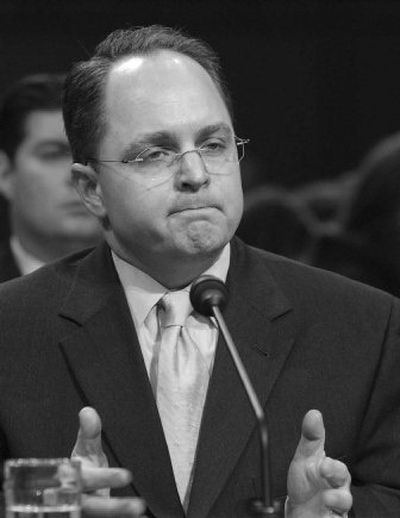E-mails suggest politics in firings

WASHINGTON – Long before they fired a group of U.S. attorneys, senior White House and Justice Department officials were already discussing some politically connected insiders for their replacements, documents released Friday show, undercutting earlier claims that the prosecutors were terminated for purely performance reasons.
The new documents, turned over to congressional investigators in a widening probe of the firings, also show that the administration prized attorneys who shared their Republican ideology. For instance, in personnel charts some prosecutors are noted for their membership in the conservative Federalist Society.
Beginning in January of last year – 11 months before the terminations were carried out – Justice officials were deep in confidential discussions with the White House over who might get the prized political appointments.
“I recommend that the Department of Justice and the Office of the Counsel to the President work together to seek the replacement of a limited number of U.S. attorneys,” D. Kyle Sampson, then-chief of staff to Attorney General Alberto Gonzales, wrote in a January 2006 private memo to then-White House Counsel Harriet Miers and her deputy, William Kelley.
Sampson then listed four candidates to replace them: Dan Levin, a former senior Justice and White House official; Jeff Taylor, now the U.S. attorney in Washington, D.C.; Deborah Rhodes, now the top prosecutor in Alabama; and Rachel Brand, currently head of the department’s Office of Legal Counsel.
Under Sampson’s plan, Levin was mentioned to replace Kevin Ryan, who was fired as the U.S. attorney in San Francisco; Taylor or Rhodes to take over for Carol Lam, fired in San Diego; and Brand to succeed Margaret Chiara, fired in Grand Rapids, Mich.
Sampson also listed H.E. “Bud” Cummins III of Little Rock, Ark., as another to be fired, and to be replaced by Timothy Griffin, a protege of White House political adviser Karl Rove.
“Please let me know how you would like to proceed,” he added. “The first steps, I think, would be (1) to agree on the target list of U.S. attorneys and (2) ask EOUSA (their supervisors) to begin quietly calling them to ascertain their intentions for continued service, indicating to them that they might want to consider looking for other employment.”
A total of eight prosecutors were eventually fired – Cummins last summer and the other seven in December.
Officials first insisted that the job actions were based solely on poor performance evaluations, although they did acknowledge that Cummins was pushed aside to make way for Griffin in that post.
But their stance has steadily drawn more questions from congressional Democrats, and the new documents, part of some 2,400 pages delivered to Capitol Hill on Friday, are likely to prompt even more queries when Gonzales testifies Tuesday before the Senate Judiciary Committee.
That is because Sampson’s e-mail to Miers and Kelley appears to conflict with what Sampson said in his own testimony to the committee last month, when he denied that he had specific names in mind as replacements for the fired prosecutors. “I personally did not,” he told the committee.
Sen. Charles E. Schumer, D-N.Y., who is leading the investigation in the Judiciary Committee, said the documents strongly suggest the firings were politically driven, and that the issue of already having replacements will be a key subject when Gonzales appears there Tuesday.
Earlier this year, the attorney general said he would never allow prosecutors to be removed for political reasons.
But Schumer said that “today makes clear that they did have a list of replacements. And that is extremely troubling, and it goes to the core of why certain attorneys were chosen to be fired.”
Sampson’s attorney, Brad Berenson, argued, however, that Sampson’s testimony was “entirely accurate.” He said that when the seven prosecutors were asked to step down in December, “no specific candidate had been selected to replace any of them, and Kyle had none in mind.”
Berenson added that “some names had been tentatively suggested for discussion much earlier in the process, but by the time the decision to ask for the resignations was made, none had been chosen to serve as a replacement. Most, if all, had long since ceased even to be possibilities.”
Brian Roehrkasse, a Justice spokesman, echoed that assertion. “The list,” he said, “reflects Kyle Sampson’s initial thoughts, not pre-selected candidates by the administration.”
Sampson has since resigned.